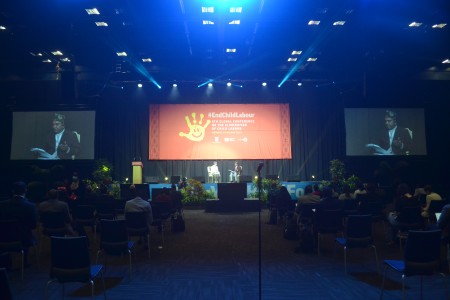
Acting together to eliminate child labour in agriculture
Acting together to eliminate child labour in agriculture

A total of 70 percent of all children engaged in child labour were in agriculture and this is the only sector in recent years that has seen an increase in child labour - delegates were told during the 5th Global Conference on the Elimination of Child Labour.
Bernd Seiffert, Focal Point for Child Labour in Agriculture, Food and Agriculture Organization (FAO) of the United Nations said the effects of the COVID-19 pandemic have pushed more children further into child labour.
Seiffert said eliminating child labour in the agricultural sector was a collective effort among all stakeholders. He said agriculture needs cross-sectoral solutions where stakeholders work together to eliminate child labour.
He identified: quality education, vocational training, social protection, women’s empowerment, climate-smart practices, proper natural resources management and collaboration between the ministries of agriculture, labour and employment as some of the policy instruments that can be used to eliminate child labour in the agriculture sector.
Seiffert was speaking at Inkosi Alert Luthuli International Convention Centre in Durban during a panel discussion on the subject of Making a breakthrough in agriculture to end child labour. The panel was to give voice to global, regional, national and local actors who are contributing to addressing child labour in agriculture in different subsectors.
International Labour Organization (ILO) and the United Nations Children’s Fund (UNICEF) report titled: “Child Labour: Global estimates 2020, trends and the road forward” - estimates that 160 million children – 63 million girls and 97 million boys – were in child labour globally at the beginning of 2020, accounting for almost 1 in 10 of all children worldwide. Seventy-nine million children – nearly half of all those in child labour – were in hazardous work that directly endangers their health, safety and moral development.
Thoko Didiza, South Africa’s Minister of Agriculture, Land Reform and Rural Development said at the heart of the problem was addressing the root causes of child labour. Didiza said agriculture remains an important sector of the economy and development - and addressing child labour will require a multi-functional approach.
Didiza said another challenge helping to perpetuate child labour in the sector was inadequate compliance and lack of information.
“In small-holder farms – children more often become part of the labour force. We need to also deal with stimulus factors to help release children to get an education. Child labour is not only restricted to emerging farmers but is also found in commercial farming and this is more evident during the harvesting season,” she said.
She called for more collaboration with other ministries and the inspectorate to ensure enforcement and compliance. Didiza also said advocacy was another critical component of dealing with child labour – so as to educate society at large.
Mopholosi Morokong, Regional Occupational Health and Safety Officer: International Union of Food, Agricultural, Hotel, Restaurant, Catering, Tobacco and Allied Workers’ Associations, South Africa said one of the drivers of child labour was poor wages. Morokong said the implementation of the ‘piece rate’ pay structure – where employees are paid to complete a particular task by every unit created or harvested – undermines efforts to challenge and eliminate child labour.
He said the second problem is the denial of the right to freedom of association to workers.
“Workers' voices are suffocated, and if voices of the workers are suffocated they are unable to engage in collective bargaining so that they improve wages and this is a problem. As a result of that, there are also health and safety consequences such as ‘social hazards’ which means – workers become ill, do not get wages, and there is no social protection,” he said.
Morokong called for a strict monitoring system to ensure compliance and an anonymous reporting system.
The week-long conference ends tomorrow (20 May) with a session on the lessons learnt and a path forward including the adoption of the Durban Call to Action programme.
#EndChildLabour



